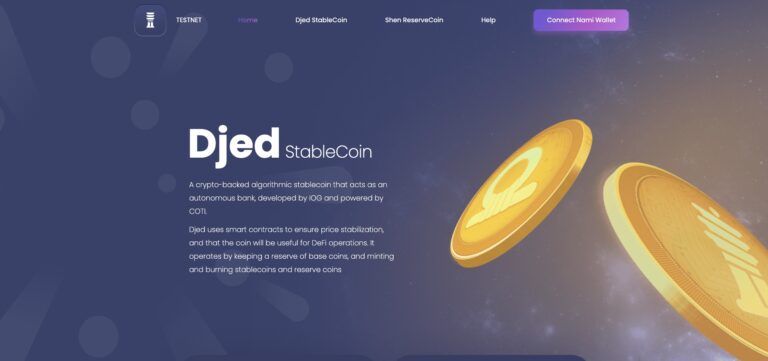On Tuesday (May 10), In the wake of the fall from grace of Terra ecosystem’s algorithmic stablecoin TerraUSD ($UST) in the past few days, FinTech startup COTI Group CEO Shahaf Bar-Geffen explained how his algorithmic stablecoin Djed (which is built on Cardano) is different and why its dollar peg has not been affected.
What Is Djed?
On Sunday (September 26), day two of the two-day Cardano Summit 2021, IO Global (IOG), the blockchain technology firm responsible for the development of Cardano ($ADA), and FinTech startup COTI Group, unveiled Djed, a new algorithmic stablecoin for Cardano that was developed by the former and is issued by the latter.
Djed’s use of smart contracts ensures price stabilization. Djed can be useful in decentralized finance (DeFi). It works by “keeping a reserve of base coins, and minting and burning stablecoins and reserve coins.”
Djed’s white paper states that the Djed protocol “behaves like an autonomous bank that buys and sells stablecoins for a price in a range that is pegged to a target price” and that Djed is crypto-backed “in the sense that the bank keeps a volatile cryptocurrency in its reserve.” It also mentions that Djed is “the first stablecoin protocol where stability claims are precisely and mathematically stated and proven.”
In a blog post published yesterday, IOG said that Djed “operates by maintaining a reserve of base coins, while minting and burning various other stable assets and reserve coins” and that “it is designed to be used for paying transaction fees on the Cardano network,” which helps to “make transaction costs more predictable, so avoiding volatile and exorbitant gas fees for users.”
The COTI team believes that “stablecoins are a ‘killer app’ that will be adopted by a large number of crypto users for settling payments and covering fees.”
Shahaf Bar-Geffen, the CEO of COTI Group, had this to say:
“The stablecoin ecosystem has matured tremendously over the past few years. Blockchain participants are using stablecoins to engage in everyday transactions because they allow monetary value to be exchanged in a seamless manner, regardless of the sender and recipient’s location. I believe that adding the Djed stablecoin to the Cardano blockchain will significantly improve how transactions are settled on the platform.“
And IOG Co-Founder and CEO Charles Hoskinson stated:
“The Djed stablecoin could be a game-changer in the crypto space, appealing to an entirely new audience at a time when the industry is already experiencing astronomical growth. Djed shares our commitment to formal verification, proving a robust method of combating price volatility of crypto markets.
“COTI has been a long-time partner of the Cardano ecosystem. It’s great to have them on board with this new venture.“
Djed’s Public Testnet Version Has Been Released
In a blog post published on May 4, COTI announced that the public testnet version of their decentralized algorithmic stablecoin has been released.
The blog post went on to say that this release allows them to “test the main functionalities of the protocol in a fictitious and safe space using trial funds and will “give everyone an opportunity to understand the dynamics of the protocol without incurring any risks.” It also mentioned that “SundaeSwap, Minswap and WingRiders are starting to test Djed through test pools on their platforms.”
The COTI team reminded everyone that “the Public Testnet’s purpose is to test all aspects of the release” and that they “expect some technical issues to arise.” As for the Public Mainnet version, they are planning to release it in June.
How Djed Is Different From Other Algorithmic Stablecoins
On May 10, the COTI CEO took to Twitter to point out that Djed had managed to maintain its 1:1 peg to USD throughout the recent crypto market turbulence, and proceeded to explain how Djed is different from other algorithmic stablecoins:
- “Djed’s algorithm is based on a collateral ratio in the range of 400%-800% for $Djed and $Shen. $ADA prices fluctuations are offset by $Shen, covering shortfalls and guaranteeing the collateralization rate.“
- “The $ADA reserve pool is not managed by market makers, but by users who mint the $Shen reserve coin and add $ADA to the pool. This provides a decentralized aspect to the $Djed mechanism. $Shen holders are incentivized to provide liquidity through fees.“
- “As $Djed can be over collateralized (up to 8x), the risk of $Djed being unpegged decreases. This means that for every 1 $Djed minted, there are 4-8 $Shen in the reserve pool.“
- “If the ratio falls below 400%, users will not be able to mint $Djed, and $Shen holders won’t be able to burn their $Shen. So in the event of a market dip there is a security blanket for $Djed holders that ensures its sustainability.“
- “The minting of new $Shen is also supervised in order to maintain the balances stabilized, and ensure there will always be enough $ADA in the pool to provide a dollar equivalent value to the $Djed when burning it.“
Disclaimer
The views and opinions expressed by the author, or any people mentioned in this article, are for informational purposes only, and they do not constitute financial, investment, or other advice. Investing in or trading cryptoassets comes with a risk of financial loss.









